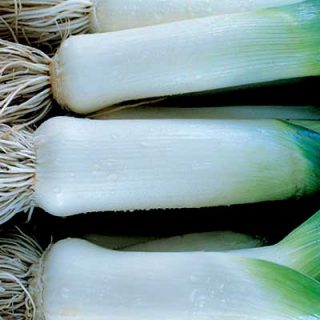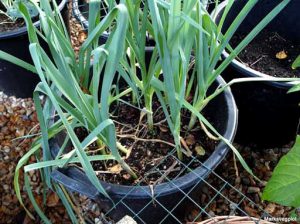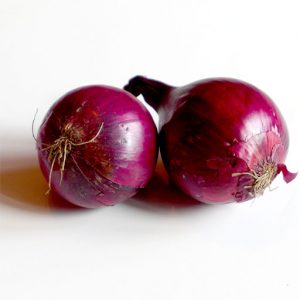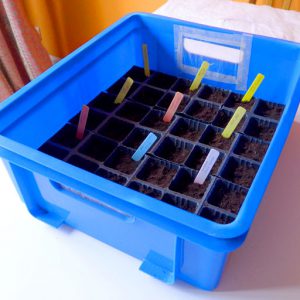
Welcome to the allium family of vegetables: onions, leeks, shallots, Welsh onions, spring onions and chives. For the summer gardener used to tomatoes, beans and cucumbers, the allium group of plants is the first step in all-year gardening since these temperate climate vegetables can be cultivated year round.
These are cool weather plants suited to early planting before summer crops and then harvested into the winter or planting late summer for over-wintering and an early summer crop the following year. This double planting provides an almost continuous supply over the year which compliments summer crops such as tomatoes, peppers and cucumbers.
This genus of plant can be divided into bulbing and non-bulbing types, with onions and shallots the bulb type and leeks and Welsh onions not producing bulbs. This simplified grouping helps to appreciate the wide range of the allium family from the humble onion to the large standing leek and all crops in between.
The challenge with this group of plants is to work with their cool weather preference to get them well started in early spring to avoid their bolting in the summer and to have them well enough established by the autumn before the winter weather to produce a fully mature crop the following year.
While the allium family of plants are slow growing they are reasonably low maintenance crops once started. In general, they require little or no watering (in Belgian conditions), except during prolonged dry spells when their shallow rooting systems can dry out. Other than watering, these plants look after themselves.
The plants of the allium family contain a chemical called allicin which has antibacterial, antiviral, and antifungal properties which has been demonstrated to significantly reduce the incidence of plant disease in neighbouring plants. These pungent plants also emit a scent that acts as an insect repellent and which also masks the odour of other crops to confuse and repel or deter insect pests such as slugs and caterpillars and most varieties of aphids.
Allium plants are good companions for tomatoes, cucumbers, peppers, lettuce, squash, carrots and strawberries. However, they are not good companions for beans or other legumes and will inhibit their growth.
Leek (Allium ampeloprasum L.)
Leeks, while part of the onion family, do not form bulbs but instead produce a long cylinder of bundled leaf sheaths. Leeks have a mild, onion-like flavour suited to boiling or frying and are used in soups (such as Scottish cock-a-leekie soup), stews or stir fries. Varieties are generally considered summer or winter types with the over-wintering varieties larger, and with a stronger flavour. They are easy to grow from seed and tolerate standing in the garden for an extended harvest.
Summer leeks are started from seed indoors between February and March. The seeds require reasonably deep pots (around 6 inches depth) or can be planted in smaller pots and then transplanted later to deeper pots. Transplanting leek seedlings is difficult as their root systems are very sensitive. Deeper pots accommodate the seedlings until they are ready for outdoor planting in April or May and help protect the roots. Potting soil must be kept damp but not wet (spray watering is good).
As with all plants started from seed indoors, it is important to carefully manage a hardening off period of several weeks in which the plants are taken outdoors gradually and protected from cold until final planting out when weather allows.
This period involves sitting the plants outdoors on mild afternoons and sunny days, bringing them inside at night, and working up towards leaving them overnight outside. This stage is important as sudden cold can damage young leek plants.
Leeks can also be purchased as small plants in early spring ready for planting out. This is recommended for those new to growing leeks or as a supplement to the gardener’s own plants raised from seed. As with most plants bought from garden stores it is worth holding back from immediate planting. Create an interim stage in which the small plants are placed in small pots outdoors, giving them a week or so to adjust to the move before final planting out (night time soil temperatures can be very cold).
Leeks require well draining soil preferably with a good content of compost and some organic feed such as seaweed extract. They do not like heavy soil so it is worth turning over the soil to a depth of 12 inches before planting. They will also grow well in large containers with good depth (9/10 inches) and produce good results.
The white section of a finished leek, below the green leaves, is created through a process called “blanching.” This involves planting the seedling deeper into the soil, preferably into a larger hole and watering it in, and then mounding the soil up around the plant as it grows. This causes the section below soil to remain white. While this process produces a better leek, normal planting with some mounding later in the summer will produce quite adequate results.
Leeks planted in the spring will be ready for harvesting in the autumn and can be left standing in the ground or containers into the winter for later picking. Immature plants can be picked at any time during the summer and autumn months for immediate use.
Winter leeks, planted over winter for harvest the following spring (April/May), can be started from seed direct in situ towards the end of summer or started separately in pots for planting out when summer beds or containers are emptied. The main thing with over-wintering leeks is to have healthy small plants in place and growing before the hard weather arrives.
France, Belgium, and the Netherlands lead the world in commercial leek production making this crop a natural choice for the Brussels kitchen gardener wanting to extend their summer season to all year round.
Onion (Allium cepa L.)
Also known as the bulb onion or common onion, the onion plant has hollow, bluish-green leaves and a bulb at the base. It is the most widely cultivated species of the allium family and generally come in three colours: yellow, red and white.
The plant can be eaten at all stages of growth before mature bulbs are harvested. Onions are day-length sensitive in their growth, with varieties divided between long-day, intermediate-day and short-day types. Onions are a cool-weather crop suited to early planting in the year after the last frost and before summer crops are even started.
The easiest way to start onions is from sets, small immature onions that are available from garden shops. These are planted outdoors after the last frost just below the surface of the soil in such a way that later in the year, as the onion bulb swells, it can be exposed to the light. Sets can also be started indoors in pots or containers if the weather outdoors is uncertain (i.e. heavy rain), providing starter plants for planting out in March or April.
Onions can be grown from seed started indoors in February in trays and brought on through to planting outdoors in late March or April. Onion seed does not keep well from year to year so new seed should be used. The seeds germinate relatively easily but the small seedlings are notoriously difficult to handle or transplant as they are hair thin and have sensitive root systems.
In this respect, growing from seed in larger pots or containers over six to eight weeks allows for larger seedlings to develop which are easier to handle. The leaf growth on seedlings can be trimmed back after a few weeks to encourage sturdy plants. Onion seedlings should be kept in a cool area of the house while they establish. As with leeks, onion seedlings require hardening off over a week or two before being planted out in their final position.
Onions require a well-draining loose soil such as a raised bed. They will also grow well in larger pots or containers but not growbags. Onions generally require four- inch spacing but can also be grown in tight clusters of four plants where each plant will force its own space. Onion sets are planted just below the soil surface with the tip exposed, while onion plants are planted slightly deeper.
One problem to watch for with onions is bolting (the plant flowering). This can be brought on early if the spring or early summer has unseasonably wet or cold weather (like last year). As soon as flowering heads on stalks are observed, it is worth removing these to one inch above the bulb. While the plant will now be stunted in its growth, it will remain perfectly edible and can be left to continue for use whenever needed. Early bolting only affects the storage life of onions after harvest. Most onions sets are heat treated to prevent this occurring.
Onions are ready for harvesting when the foliage turns yellow and starts to fall over. The onions can then be lifted as required over the following weeks or lifted as a whole crop for drying. Drying onions for storage requires about two weeks in warm dry conditions.
Shallot (Allium ascalonicum L.)
Shallots have a mild flavour between onion and garlic that is prized by chefs. They are used extensively in Asian and Middle Eastern cooking. They grow in clusters of offsets with a head composed of multiple cloves similar to garlic. Also called the eschalot or French shallot, shallots have a distinctive shape and can be brown, red or grey in colour.
Shallots are started in the same way as onion sets, with the bulb pushed into the soil so that just the pointed top is exposed. They work well in soil beds, pots and containers. Shallots grown from sets grow into a dense nest of a dozen or more shallots. Seed-sown varieties will produce 3 to 4 per shallots per plant.
Spring Onions
There are a range of onion types than can be generally grouped as spring onions, although they have many other names in various cultures. These are different from general onions in that they are grown for their leaf stems and have little or no bulb (like miniature leeks).
These types are started and grown in just the same way as onions. They are started from seed indoors in February and March for an early start but can then also be planted directly outdoors throughout the growing season to maintain a good crop. They can be harvested by cutting the stalks, leaving one inch above the soil to regrow. The Welsh Onion and Chives are perennial and will regrow each year for several years
Spring Onion (Allium cepa var. cepa): Also called the scallion, green onion and salad onion, the spring onion gets its name as the plant is used before it has a fully-developed root bulb. The green tops and the white root are both eaten. Spring onions can be sown wherever there is space in beds or in containers and can be ready for picking in about 10 weeks.
Welsh onion (Allium fistulosum): Also called the bunching onion, green onion, Japanese bunching onion, scallion and spring onion, is a species of perennial onion. The Welsh onion does not develop bulbs and has hollow leaves and scapes. It multiplies once planted forming evergreen clumps which makes it suitable for inclusion in herb beds. It is used in a wide range of cuisine and will grow in containers and soil beds.
Chives (Allium schoenoprasum): Chives are grown for their scapes which are used in many types of cooking as a flavouring herb. A perennial plant, chives are often planted in permanent herb beds or as border plants around other crops as their insect-repelling properties deter pests. Chives form bulbs which grow in dense clusters from the roots.
Problems
Plants in the allium genus are all generally affected by the same range of disease and pest problems.
Onion white rot is a serious disease of plants of the allium family plants, especially onions, garlic and leeks. It is caused by a soil-borne fungus which can persist in the soil for many years. The symptoms, visible from mid summer, include yellowing and wilting of foliage and rotting of bulbs and roots. This fungal disease has no treatment. Planting in containers and pots can help to avoid this problem.
Leek rust is a disease caused by a fungus on leeks mainly, but it also affects onions, garlic and chives. The fungus causes bright orange raised spots on leaves. This disease affects the vigour of the plant, reducing the crop. On harvesting all dead material should be disposed of and not composted.
Onion downy mildew is caused by a fungus-like organism which infects the leaves and bulbs of onions and shallots. It is prevalent in cool wet weather in late spring or summer and causes leaves to die off from the tip downwards. Affected plants should be removed and destroyed (not composted).
The majority of problems affecting the allium family are soil borne infections. A bad outbreak of these problems requires avoiding planting these crops in the same area again for several years. For the small city gardener these problems can be avoided by growing alliums in large containers and pots where good clean potting soil is used.
Conclusion
Growing onions and leeks in a small city garden is a good opportunity for the summer gardener to extend the growing season year round. It is an opportunity to use the garden beds, pots and containers during the winter months and for getting an early start on the gardening year, starting in February.
(marksvegplot.blogspot.be)
































